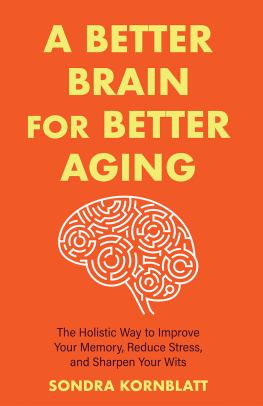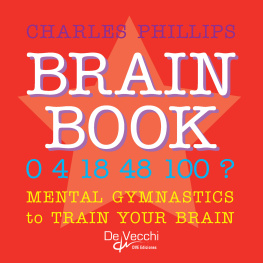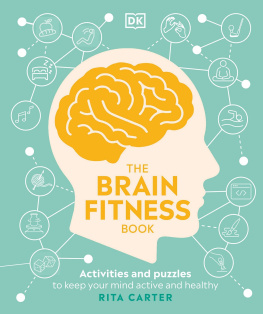Keep Your Brain Alive
83 Neurobic Exercises to Help Prevent Memory Loss and Increase Mental Fitness
Lawrence C. Katz, Ph.D. & Manning Rubin
Illustrations by David Suter
Workman Publishing Company New York
Acknowledgments
We both thank Peter Workman for being our matchmaker, and our editor, Ruth Sullivan, for her steadfast faith in the project and her relentless pursuit of clarity and simplicity in the writing and organization of the material.
Larry Katz wishes to thank Doris Iarovici, his spouse, for her critical insights, advice, and editorial assistance, and Bonnie Kissell, for unflagging administrative support of this project.
Manning Rubin thanks Jane Rubin, for bearing the brunt of his burying himself in the research, writing, and rewriting he has been obsessed with for two years, and for her level-headed observations that helped the book. And he thanks Larry for the voluminous work he has produced in keeping this book alive.
Contents
Foreword
Our brains are hardwired to seek out anything new and stimulating.
Scientists explain this phenomenon as an evolutionary adaptation: Early humans who could spot a predator quickly enough to survive passed on this novelty-seeking trait to their offspring. Thanks to this selective advantage in brain evolution, something new always tweaks our attention. However too much novelty can be unsettling, which is why humans are also such creatures of habit. We all have our routines: Some eat the same breakfast every morning, take the same route to work each day, or do the jumbles in the morning newspaper. But there is good reason to mix things up. Experiments have shown that when we break our patterns and use our senses in novel ways, we stimulate our nerve cells and thus contribute to the growth, strength, and agility of our brains.
How lucky for us, then, that Keep Your Brain Alive offers simple, practical ways to shake up our mental routines and give our brains a workout. By practicing the unique sensory-engaging exercises that Lawrence Katz and Manning Rubin call Neurobics, youll stimulate your sleepy neurons and help keep them healthy and fit.
An effective physical fitness trainer provides cross-training routines that include not just cardiovascular work, but also strength and balance training. Similarly, Neurobics give your brain a complete workout so you build cognitive reserve and even grow new dendrites (the branches on nerve cells that form the basis of memory). These simple exercises are distinctive in that they utilize the senses to help the brain forge new associations between disparate types of information (say, connecting a scent with a particular flower). Each of our senses has its own bit of real estate in the brain. And unless you exercise all of these areas, you are neglecting millions of neuron pathways that need stay fit in order to store and retrieve information.
Keep Your Brain Alive not only provides more than eighty of these fun, effective exercises, but makes it easy to integrate them into your daily life. Whether youre at work, home, shopping, or sharing a meal with family or friends, you can work on your mental fitnessthere is no need to find a special time or place. And what a boon that is: My research group has found that even relatively brief brain exercise periodslasting less than an hour each day for only a week or twocan result in significant increases in brain neural networks.
Maintaining brain health involves physical and mental exercise, stress management, and a healthy diet. Doing the Neurobics in Keep Your Brain Alive is essential to fortifying these strategies and maintaining a healthy brain.
Gary Small, M.D.
Coauthor, The Alzheimers Prevention Program: Keep Your Brain Healthy for The Rest of Your Life
Preface
As the population of over 76 million Baby Boomers move through middle age and beyond, the issue of preserving mental powers throughout greatly increased life spans has reached an almost fever pitch. There is a growing interest inand optimism aboutpreserving and enhancing the brains capabilities into senior years.
With the help of powerful tools of molecular biology and brain imaging, neuroscientists around the world have literally been looking into the mind as it thinks. Almost daily, they are discovering that many of the negative myths about the aging brain are, indeed, only myths: Older and wiser is not just a hopeful clich but can be the reality. In much the same way that you can maintain your physical well-being, you can take charge of your mental health and fitness.
Although relatively new and therefore not yet proved by a large body of tests, Neurobics is based on solid scientific ground; it is an exciting synthesis of substantial findings about the brain that provides a concrete strategy for keeping the brain fit and flexible as you grow older.
From Theory to Practice
Jane reached into her pocketbook and fished inside for the keys to her apartment. Usually they were in the outside flap pocket but not today. Did I forget them?! Nohere they are. She felt their shapes to figure out which one would open the top lock. It took her two tries until she heard the welcome click of the lock opening. Inside the door she reached to the left for the light switchbut why bother? Her husband would do that later. Touching the wall lightly with her fingertips, she moved to the closet on the right, found it, and hung up her coat. She turned slowly and visualized in her mind the location of the table holding her telephone and answering machine. Carefully she headed in that direction, guided by the feel of the leather armchair and the scent of a vase of birthday roses, anxious to avoid the sharp edge of the coffee table and hoping to have some messages from her family waiting.
The table. The answering machine. She reached out and brushed her fingers across what she believed to be the play button. What if I push the delete button? she thought, and again checked to make sure she was right. Yesterday it was so easy. She could have done all this simply by looking around. Today was different. She could see nothing.
But Jane had not suddenly gone blind. At age 50, she was introducing a lifestyle strategy called Neurobics into her daily activities. Based on recent discoveries in brain science, Neurobics is a new form of brain exercise designed to help keep the brain agile and healthy. By breaking her usual homecoming routine, Jane had placed her brains attentional circuits in high gear. With her eyes closed, she had to rely on her senses of touch, smell, hearing, and spatial memory to do something they rarely didnavigate through her apartment. And she was involving her emotional sense by feeling the stresses of not being able to see. All these actions created new and different patterns of neuron activity in her brainwhich is how Neurobics works.
This book will explain the principles behind Neurobics and how the exercises enhance the overall health of your brain as you grow older.
Chapter 1
Neurobics: The New Science of Brain Exercise
What was the name of that actor who was in all the early Woody Allen films? You knowcurly brown hair?
The first time you forget the name of a person you should know, a movie title, or an important meeting, youre likely to exclaimonly half-jokinglyIm losing it! My brain is turning to Jell-O. Reinforced by messages and images in the mass media, you equate mild forgetfulness with the first stages of accelerating mental decline.








